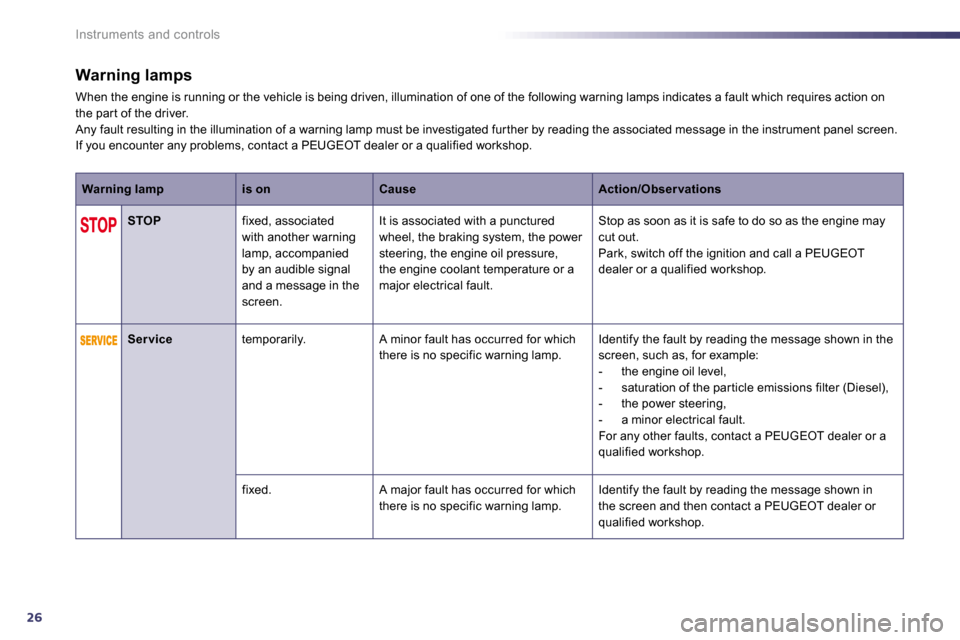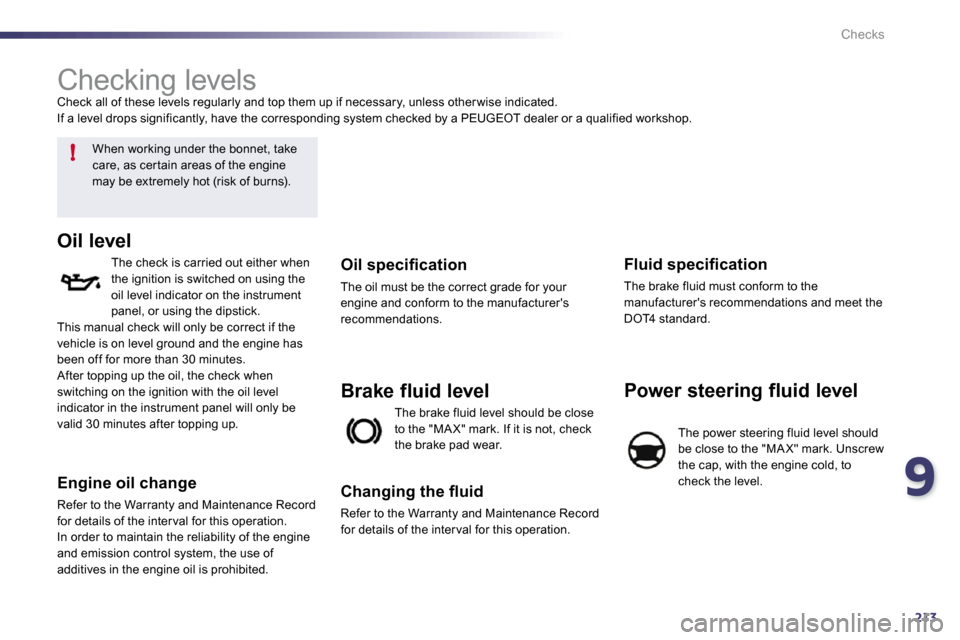Page 26 of 330

26
Instruments and controls
Warning lamps
When the engine is running or the vehicle is being driven, illumination of one of the following warning lamps indicates a fault which requires action on the par t of the driver. Any fault resulting in the illumination of a warning lamp must be investigated fur ther by reading the as sociated message in the instrument panel screen. If you encounter any problems, contact a PEUGEOT dea ler or a qualified workshop.
Warning lampis onCauseAction/Obser vations
STOP fixed, associated with another warning lamp, accompanied by an audible signal and a message in the screen.
It is associated with a punctured wheel, the braking system, the power steering, the engine oil pressure, the engine coolant temperature or a major electrical fault.
Stop as soon as it is safe to do so as the engine may cut out. Park, switch off the ignition and call a PEUGEOT dealer or a qualified workshop.
Ser vice temporarily. A minor fault has occurred for which there is no specific warning lamp. Identify the fault by reading the message shown in the screen, such as, for example: - the engine oil level, - saturation of the par ticle emissions filter (Diesel), - the power steering, - a minor electrical fault. For any other faults, contact a PEUGEOT dealer or a qualified workshop.
fixed. A major fault has occurred for which there is no specific warning lamp. Identify the fault by reading the message shown in the screen and then contact a PEUGEOT dealer or qualified workshop.
Page 126 of 330

114
i
!
Driving
Stop & Start
The Stop & Star t system puts the engine temporarily into standby - STOP mode - during stops in the traffic (red lights, traffic jams, or other...). The engine restar ts automatically - START mode - as soon as y ou want to move off. The restar t takes place instantly, quickly and silently. Per fect for urban use, the Stop & Star t system reduce s fuel consumption and exhaust emissions as well as the noise level when stationary.
Operation
Going into engine STOP mode
The "ECO" warning lamp comes on in the instrument panel and the engine goes into standby:
- with the electronic gear control gearbox, at speeds below 4 mph (6 km/h), press the brake pedal or put the selector lever in position N .
If your vehicle is fitted with the system, a time counter calculates the sum of the periods in STOP mode during a journey. It rests itself to zero every time the ignition is switched on with the key.
Never refuel with the engine in STOP mode; you must switch off the ignition with the key.
For your comfor t, during parking maoeuvres, STOP mode is not available for a few seconds after coming out of reverse gear. STOP mode does not affect the functionality of the vehicle, such as for example, braking, power steering...
Special cases: STOP mode not available
STOP mode is not invoked when:
- the driver's door is open, - the driver's seat belt is not fastened, - the vehicle has not exceeded 6 mph (10 km/h) since the last engine star t using the key, - the electric parking brake is applied or being applied, - the engine is needed to maintain a comfor table temperature in the passenger compar tment, - demisting is active,
- some special conditions (battery charge, engine temperature, braking assistance, ambient temperature...) where the engine is needed to assure control of a system. In this case, the "ECO" warning lamp flashes for a few seconds then goes off. This operation is per fectly normal.
Page 226 of 330
210
Checks
checking the levels of the various fluids and for replacing cer tain components.
Petrol engines
1. Power steering reser voir. 2. Screenwash and headlamp wash reser voir. 3. Coolant reser voir. 4. Brake fluid reser voir. 5. Battery/Fuses. 6. Fusebox. 7. Air filter. 8. Engine oil dipstick. 9. Engine oil filler cap.
1.6 16V VTi 120 hp
1.6 16V THP 155 hp
Page 227 of 330
9211
Checks
The various caps and covers allow access for checking the levels of the various fluids, for replacing cer tain components and for priming the fuel system.
* According to engine.
Diesel engines
1. Power steering reser voir. 2. Screenwash and headlamp wash reser voir. 3. Coolant reser voir. 4. Brake fluid reser voir. 5. Battery/Fuses. 6. Fusebox. 7. Air filter. 8. Engine oil dipstick. 9. Engine oil filler cap. 10. Priming pump * . 11. Bleed screw * . 1.6 Turbo HDi 110 hp
2.0 Turbo HDi 140 hp
Page 228 of 330
212
Checks
checking the levels of the various fluids, for replacing cer tain components and for priming the fuel system.
* According to engine.
Diesel engines
1. Power steering reser voir. 2. Screenwash and headlamp wash reser voir. 3. Coolant reser voir. 4. Brake fluid reser voir. 5. Battery/Fuses. 6. Fusebox. 7. Air filter. 8. Engine oil dipstick. 9. Engine oil filler cap. 10. Priming pump * . 11. Bleed screw * . 2.0 Turbo HDi 163 hp
2.2 Turbo HDi 200 hp
Page 229 of 330

9213
!
Checks
Checking leve ls
Check all of these levels regularly and top them up if necessary, unless other wise indicated. If a level drops significantly, have the corresponding system checked by a PEUGEOT dealer or a qualified wo rkshop.
When working under the bonnet, take care, as cer tain areas of the engine may be extremely hot (risk of burns).
Oil level
The check is carried out either when the ignition is switched on using the oil level indicator on the instrument panel, or using the dipstick. This manual check will only be correct if the vehicle is on level ground and the engine has been off for more than 30 minutes. After topping up the oil, the check when switching on the ignition with the oil level indicator in the instrument panel will only be valid 30 minutes after topping up.
Engine oil change
Refer to the Warranty and Maintenance Record for details of the inter val for this operation. In order to maintain the reliability of the engine and emission control system, the use of additives in the engine oil is prohibited.
� � �O�i�l� �s�p�e�c�i�fi� �c�a�t�i�o�n�
The oil must be the correct grade for your engine and conform to the manufacturer's recommendations.
The brake fluid level should be close to the "MA X" mark. If it is not, check the brake pad wear.
Brake fluid level
� � �C�h�a�n�g�i�n�g� �t�h�e� �fl� �u�i�d�
Refer to the Warranty and Maintenance Record for details of the inter val for this operation.
� � �F�l�u�i�d� �s�p�e�c�i�fi� �c�a�t�i�o�n�
The brake fluid must conform to the manufacturer's recommendations and meet the DOT4 standard.
Power steering fluid level
The power steering fluid level should be close to the "MA X" mark. Unscrew the cap, with the engine cold, to
check the level.